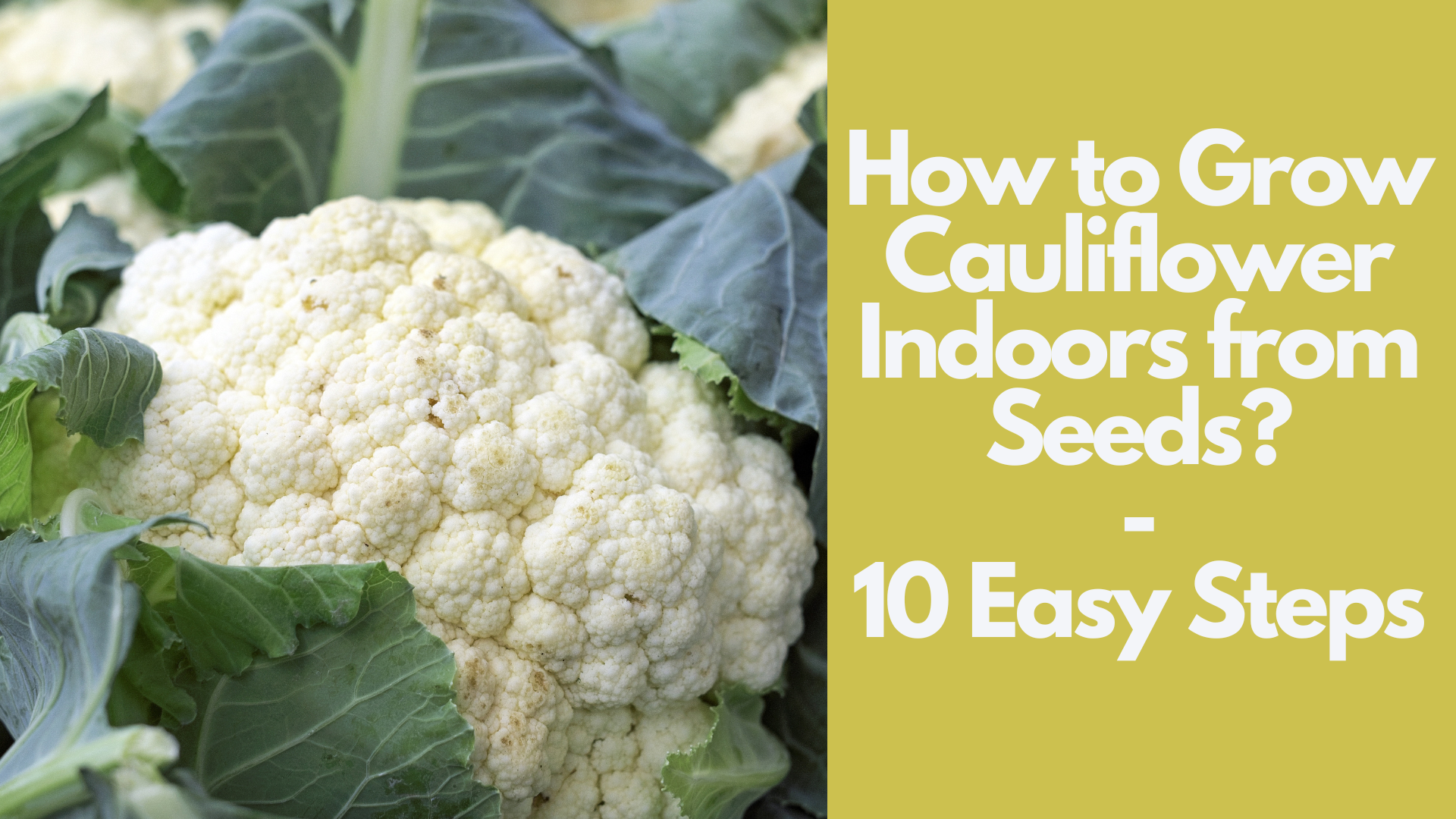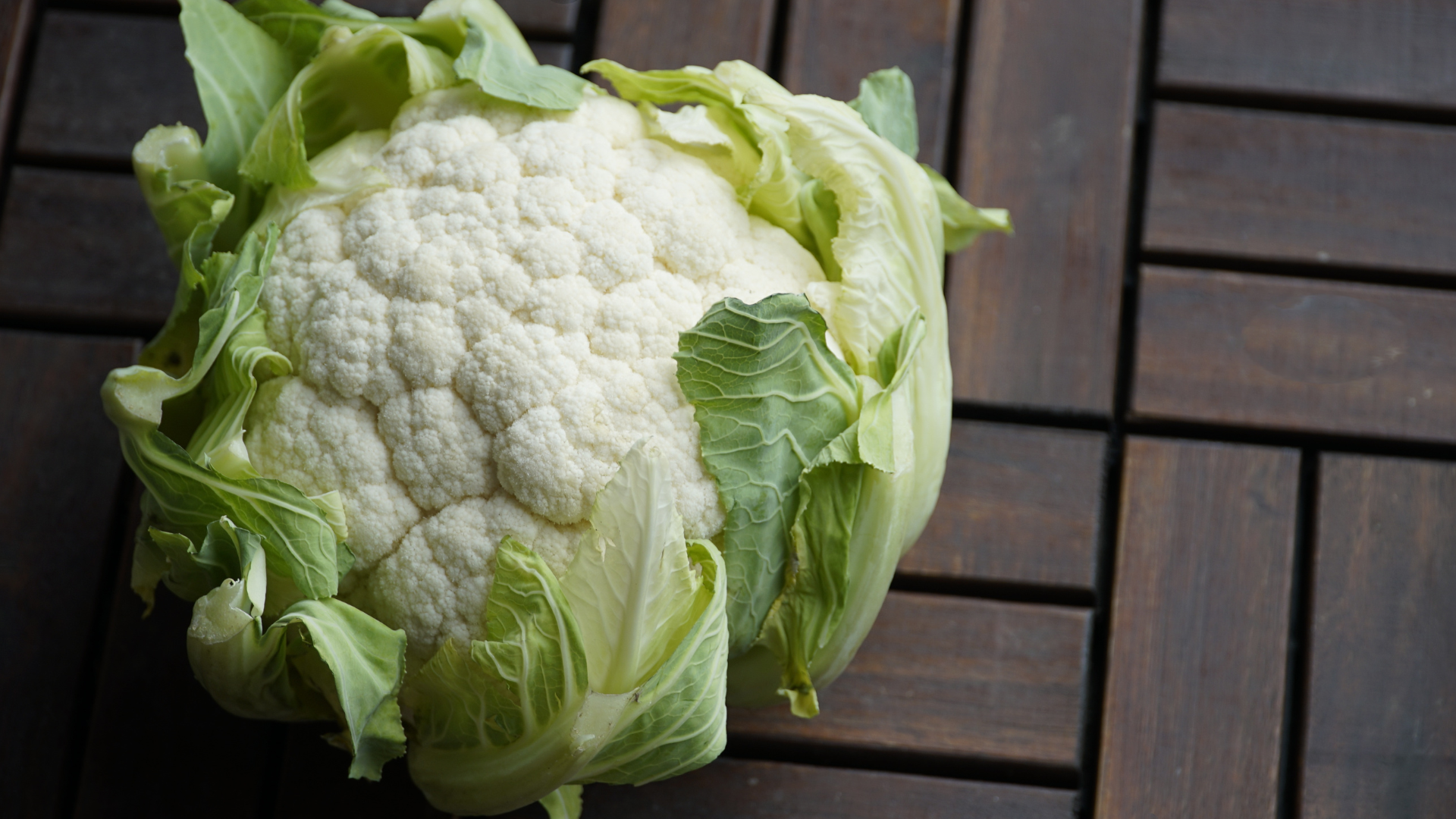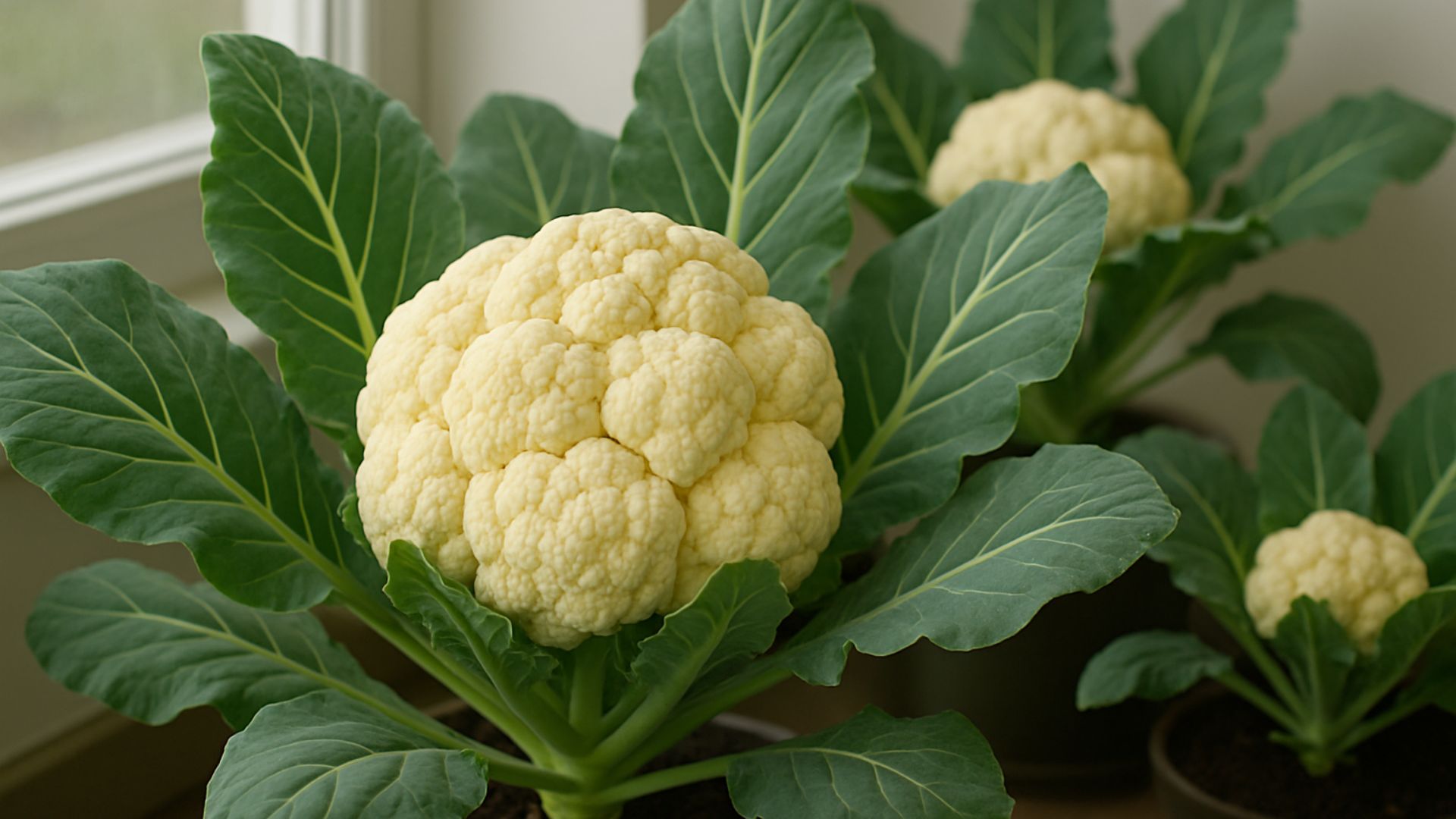Want to grow cauliflower indoors from seeds with ease? This step-by-step guide covers 10 simple and effective steps to help you grow cauliflower indoors from seeds successfully. Growing cauliflower indoors from seeds is a fantastic way to enjoy fresh, homegrown veggies regardless of the season or outdoor space. This guide explains how to choose the best soil, containers, and lighting to create the perfect environment to grow cauliflower indoors from seeds.
You’ll learn how to start seeds properly, care for seedlings, and maintain ideal temperature and humidity levels. Whether you’re a beginner or an experienced gardener, these tips make it easy to grow cauliflower indoors from seeds and achieve a healthy, bountiful harvest. By following expert advice, you can avoid common pitfalls and ensure your indoor cauliflower plants thrive. Start your indoor gardening journey today and discover how rewarding it is to grow cauliflower indoors from seeds. By reading this guide, you’ll be able to know How to Grow Cauliflower Indoors from Seeds: 10 Easy Steps.

How to set up the perfect indoor growing environment for cauliflower?
Setting up the perfect indoor growing environment for cauliflower is essential to ensure healthy growth and a bountiful harvest. Since cauliflower has specific requirements, carefully controlling the indoor environment can make all the difference.
Which important factors should you consider?
Here are the main factors to consider when growing cauliflower indoors from seeds.
1. Light
Cauliflower requires plenty of light to develop properly. For ideal results, make sure it gets 6 or more hours of direct sunlight every day. If your space lacks natural light, using full-spectrum LED grow lights is essential. These lights simulate natural sunlight and provide the necessary spectrum for strong photosynthesis. Place the lights 6-12 inches above the plants and set them to be on for 12-16 hours a day to mimic a full growing season.
2. Temperature
Cauliflower grows best in cool, consistent temperatures ranging from 18°C to 22°C (65°F to 72°F). It’s important to avoid exposing cauliflower to heat stress, which can stunt growth and cause bolting.
Place your cauliflower in a room that remains within this temperature range throughout the day and night. If you live in a particularly warm environment, consider placing the plants near an air-conditioned area or using a fan to regulate airflow.
3. Humidity
Cauliflower prefers moderate humidity levels, ideally between 50-70%. Low humidity indoors, especially in winter, can negatively affect the plant.
To maintain proper humidity, use a humidity tray underneath the plant, or place a small humidifier nearby to maintain the ideal moisture levels. Misting the plants occasionally can also help, but avoid over-wetting the leaves, which can lead to mold growth.
4. Containers and Soil
Choose deep pots or containers with good drainage holes, as cauliflower’s roots need plenty of space to grow. Use a 5-gallon container for one plant, and fill it with a potting mix that drains well and is high in organic matter to provide essential nutrients. You can mix compost into the soil for added nutrition and to improve soil structure, which will help with root development and moisture retention.
5. Air Circulation
Proper air circulation is essential to keep mold, mildew, and pests at bay. Make sure your indoor growing space is well-ventilated, whether through natural airflow or by using a small oscillating fan to promote gentle airflow. Good circulation helps prevent fungal infections and ensures that your cauliflower plants stay strong and healthy.
6. Space Considerations
Cauliflower plants need sufficient space to spread out and develop their heads properly. If you’re growing multiple plants, ensure they are spaced at least 12-18 inches apart. This will allow each plant ample room for healthy root growth and proper airflow. Crowded plants are more likely to develop diseases and struggle to form good heads.
7. Monitoring and Adjusting Conditions
Finally, regularly monitor the environment. You can use a digital thermometer and humidity gauge to track temperature and moisture levels. Adjust your grow lights, ventilation, and humidity levels as needed to keep everything within optimal ranges. Keeping track of your indoor garden’s conditions will help prevent potential issues and optimize your cauliflower’s growth.
How to grow cauliflower indoors from seeds step by step?
Growing cauliflower indoors is a rewarding experience, especially when you follow the right steps. This step-by-step guide will walk you through the process, from seed starting to transplanting, ensuring your cauliflower grows successfully indoors.
Step 1: Choose the right cauliflower variety
Start by selecting a cauliflower variety that suits indoor growing.
How do you choose the right cauliflower variety for indoor growing from seeds?
When selecting a cauliflower variety for indoor gardening, it’s crucial to choose one that is compact and adaptable to the limited space and conditions of indoor environments.
What are the best cauliflower varieties for growing indoors from seeds?
Here are some of the best cauliflower varieties for growing indoors:
1. Dwarf Varieties
Dwarf cauliflower varieties are perfect for indoor gardens because they have smaller, more manageable growth habits. A great option is the Miniature White cauliflower, which grows to about 6-8 inches tall.
These compact plants are ideal for smaller containers and can easily fit into window sills or small indoor spaces. Another excellent choice is the Snowball cauliflower, which is not only compact but also produces small, dense heads, making it ideal for limited space.
2. Compact Varieties
For gardeners with slightly more space, but still working indoors, Cheddar cauliflower is a good choice. While slightly larger than dwarf varieties, it still maintains a manageable size. What sets it apart is its vibrant orange color and ability to thrive indoors with the right care. Clancy is another compact variety that forms tightly packed, medium-sized heads, perfect for indoor growing.
3. Heirloom Varieties
For those seeking something unique, heirloom varieties like Purple of Sicily or Graffiti cauliflower offer both a distinct look and a great growing experience. The Purple of Sicily produces striking purple heads and is well-suited for cooler indoor conditions. Similarly, Graffiti cauliflower, with its vibrant purple hue, is a fantastic choice for indoor gardeners looking to add some color to their space.
Why are these cauliflower varieties perfect for indoors?
The varieties listed above are specifically chosen for their compact size, quicker maturation rates, and resilience in cooler, controlled environments. By selecting smaller or dwarf cauliflower types, you can maximize your indoor growing space while still enjoying a healthy harvest. These varieties are often more heat-tolerant than larger types, making them ideal for indoor temperatures.
While many articles focus on common varieties, exploring these lesser-known or heirloom types will give your indoor garden a unique twist while still ensuring successful growth.
Step 2: Prepare your containers
Cauliflower requires deep containers to accommodate its growing roots. Select pots or containers that are at least 12 to 14 inches deep and have adequate drainage holes. This will allow the roots to spread and the plant to thrive without waterlogging.
Fill the containers with a well-draining potting mix that’s rich in organic matter. For proper root development, use a blend of compost, perlite, and peat moss to create a light, airy soil mix for cauliflower.
Step 3: Start seeds indoors
Start seeds indoors 6 to 8 weeks before the final frost. Use a seed tray or small pots filled with potting mix and sow seeds at a depth of about 1/4 inch. Keep the soil gently moist but avoid soaking it. Set the trays in a sunny spot or under full-spectrum grow lights to promote healthy seedlings.
Tip: Keep the room temperature around 18°C to 22°C (65°F to 72°F) to encourage germination, which usually takes about 7-10 days.
Step 4: Transplant seedlings into larger pots
Once the seedlings have developed 2-3 sets of leaves, they’re ready to be transplanted into their final pots. Remove the seedlings gently from the tray, ensuring the roots remain intact. Transplant each seedling into its own 5-gallon pot or another large container. Avoid planting too deep by matching the soil level to that of the seed tray, which helps reduce stress on the plant.
Step 5: Provide adequate light
To grow cauliflower indoors from seeds, it’s crucial to monitor and maintain adequate lighting for healthy growth.
How much light does cauliflower need indoors?
Cauliflower requires a minimum of 6 hours of direct sunlight or 12 to 16 hours of light from grow lamps daily. Position the plants near a south-facing window if possible. If not, place the pots under full-spectrum LED grow lights. Keep the lights about 6-12 inches above the plants to ensure they get the right amount of light for strong growth.
Step 6: Maintain proper temperature and humidity
Cauliflower thrives in cool temperatures between 18°C to 22°C (65°F to 72°F). Avoid placing your plants near heat sources, as they can cause stress and lead to bolting (premature flowering). Indoor humidity should be maintained between 50-70%. If the indoor air is too dry, consider using a humidity tray or a humidifier to maintain optimal conditions.
Step 7: Water and fertilize regularly
Water the cauliflower plants consistently, but be careful not to overwater. The soil should remain moist, not soggy. Deep watering is recommended, ensuring that the roots receive enough moisture. Fertilize the plants every 2-4 weeks with a balanced, organic fertilizer, or use a slow-release nutrient mix. This will support healthy growth and help form strong heads.
Step 8: Thin and Prune
As your cauliflower grows, thin out any crowded plants to allow for better airflow and growth. Clear away any weeds or debris near the plant to promote healthy growth. Additionally, prune any yellow or damaged leaves to improve plant health.
Step 9: Monitor for pests
While cauliflower is relatively resistant to pests, keep an eye out for common indoor garden pests like aphids, spider mites, and whiteflies. If you spot any, use an organic pest control method such as neem oil or insecticidal soap to address the issue.
Step 10: Harvesting your cauliflower
Harvesting your indoor-grown cauliflower at the right time is key to enjoying its best flavor and texture. Here’s how to know when it’s ready and the proper way to harvest it.

When to harvest cauliflower indoors?
Indoor cauliflower is typically ready for harvest 50–70 days after transplanting, depending on the variety. Aim for a solid, compact curd that’s approximately 6 to 8 inches wide. The florets should be tightly packed, and the head should have a creamy white color (or the expected shade for your chosen variety).
Avoid waiting too long, if the head starts to spread, turns yellow, or shows signs of flowering (bolting), it’s past its prime and may taste bitter.
How to harvest cauliflower indoors?
- Use a sharp, sanitized knife or garden shears.
- Cut the head 2–3 inches below the base, keeping a few leaves attached to protect it.
- Harvest during the coolest part of the day for maximum freshness.
Handle the harvested head gently to prevent bruising.
What are the post-harvest tips?
Store your cauliflower in the refrigerator, wrapped in a breathable bag or damp cloth. You can keep it fresh for as many as 7 days. Some varieties may regrow small side shoots—leave the plant in place and monitor for new growth.
How to care for indoor cauliflower successfully?
Caring for indoor cauliflower involves more than just watering. It requires consistent attention to light, temperature, humidity, and general plant health. Since cauliflower can be a bit finicky, proper maintenance and early troubleshooting are key to growing a healthy, productive plant indoors.
1. Light and Temperature Maintenance
Cauliflower thrives with 6–8 hours of direct light daily. Indoors, this usually means relying on full-spectrum LED grow lights, especially during darker months. Place the lights 6 to 12 inches above the plants and raise them as the plants grow. Avoid placing plants near heat sources like ovens or radiators.
The ideal indoor temperature is 18–22°C (65–72°F). Temperatures above 24°C (75°F) can trigger bolting, where the plant flowers prematurely and stops forming heads.
2. Watering and Humidity Control
Water your cauliflower deeply once the top inch of soil feels dry. Consistency is crucial; too little water causes wilting, while overwatering can lead to root rot.
Cauliflower also enjoys moderate humidity (50–70%). If your home is dry, particularly during winter, consider using a humidity tray or a small humidifier. Avoid misting directly onto the plant, as wet leaves can encourage fungal growth.
3. Fertilizing for Optimal Growth
Feed your plants every 2–3 weeks with a balanced organic fertilizer or compost tea. A nitrogen-rich fertilizer in the early stages promotes leafy growth, while phosphorus and potassium support head formation. Avoid over-fertilization, which can cause large leaves but small or no heads.
4. Common Problems & Solutions
- Yellow Leaves: Yellowing leaves are usually a sign of overwatering or inadequate drainage. Ensure the soil isn’t too wet and verify that your container drains properly.
- No Head Formation: Caused by too much heat, not enough light, or nutrient imbalance. Ensure proper spacing, adjust lighting, and check your fertilizing routine.
- Pests: Look out for aphids, whiteflies, and fungus gnats. Use neem oil or organic insecticidal soap and improve air circulation with a small fan.
- Leggy Plants: Place the plants nearer to the grow light or extend the amount of time they receive light.
5. Supporting Healthy Heads
When the cauliflower head reaches 2–3 inches in diameter, you can begin blanching by loosely tying the outer leaves over it. This protects it from light, keeps it tender, and prevents discoloration.
What are common indoor growing issues with cauliflower from seeds and how can I fix them?
Even with the best care, growing cauliflower indoors can come with a few challenges. Early detection and management of problems can preserve your crop and lead to a successful harvest.
1. Leggy or Weak Plants
This often happens due to insufficient light. Cauliflower needs at least 6 hours of direct sunlight or 12–16 hours under grow lights daily. Adjust the light distance and duration to strengthen growth.
2. Yellowing Leaves
Yellow leaves can result from overwatering, poor drainage, or nutrient deficiencies—especially nitrogen. Ensure your soil drains well and fertilize with a balanced organic fertilizer every 2–4 weeks.
3. No Head Formation
This issue may stem from too much heat, inconsistent watering, or excess nitrogen. Keep temperatures between 18–22°C (65–72°F), maintain steady moisture, and ensure your fertilizer is balanced.
4. Pests Indoors
Aphids, whiteflies, and fungus gnats frequently infest indoor plants. Check under leaves regularly. Use neem oil, insecticidal soap, or sticky traps for control.
5. Bolting (Early Flowering)
Caused by temperature spikes or stress, bolting stops head development. Maintain stable conditions and avoid crowding or transplant shock.
5 Best Cauliflower Types to Grow Indoors from Seeds
1. Snowball Y Improved
A classic heirloom variety, Snowball Y Improved is perfect to grow cauliflower indoors from seeds due to its compact size and fast growth. It produces smooth, white heads and matures in about 60-70 days, making it ideal for small indoor spaces.
2. Early White
Known for its quick maturation, Early White cauliflower is one of the easiest varieties to grow indoors from seeds. It forms tight, uniform curds and thrives in controlled indoor conditions with consistent light and temperature.
3. Purple of Sicily
This vibrant variety adds color and nutrition. Purple of Sicily is a fun option to grow cauliflower indoors from seeds, especially in well-lit spaces. It’s packed with antioxidants and has a sweet, mild flavor, perfect for home chefs.
4. Mini Cauliflower (Igloo)
Designed for small spaces, Mini Cauliflower (often sold as Igloo) is great for containers. If you want to grow cauliflower indoors from seeds on a windowsill or countertop, this variety is compact and matures quickly.
5. Self-Blanching Snowball
This type naturally folds its leaves over the head, protecting it from light. Self-Blanching Snowball is an excellent choice to grow cauliflower indoors from seeds, especially if you’re a beginner looking for low-maintenance success.
Watch Growing Cauliflower from Seed Time Lapse | Video
FAQs & Answers related to How to Grow Cauliflower Indoors from Seeds: 10 Easy Steps
Can cauliflower really grow indoors from seeds successfully?
Yes! With proper lighting, temperature control, and care, cauliflower can thrive indoors from seeds. Compact varieties and the use of grow lights make it easier to grow cauliflower in small spaces year-round.
What is the best variety of cauliflower for indoor growing?
Varieties like ‘Snowball Y’, ‘Mini Cauliflower’, and ‘Early White’ are ideal for indoor gardening because of their compact size and shorter growing periods.
How much light does indoor cauliflower need?
Cauliflower requires 6–8 hours of sunlight or 12–16 hours under a full-spectrum grow light per day to grow strong and form proper heads.
What size container is best for growing cauliflower indoors?
Use a container that’s at least 12–18 inches deep and wide. Providing this much space supports healthy root development and prevents plants from becoming crowded.
How often should I water indoor cauliflower?
Water when the soil’s surface, about an inch deep, is dry. The goal is to keep the soil consistently moist but not soggy to avoid root rot.
Conclusion
Growing cauliflower indoors is a rewarding way to enjoy fresh, homegrown produce year-round—no matter your space. With the right variety, proper lighting, consistent watering, and a bit of patience, even beginners can grow healthy, flavorful cauliflower at home. This guide has covered everything from setup to harvest, helping you avoid common mistakes and troubleshoot issues confidently. Whether you’re gardening in a small apartment or adding to your indoor vegetable garden, cauliflower is a great choice for nutrient-rich, delicious harvests. Follow these tips, stay consistent, and enjoy the satisfaction of growing your own food indoors.
We will meet you on next article.
Until you can read, https://gardengeo.com/why-do-my-plants-die-when-i-repot-them-how-to-solve/
